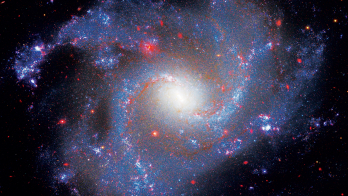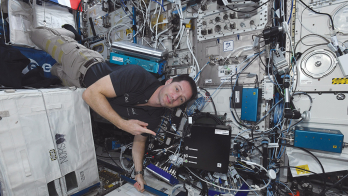Turning to unusual wavelengths, astronomers reveal new pictures of the universe. This article describes a major new gamma-ray window opening up soon in Southern Africa.
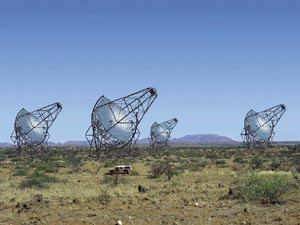
Now looming on the Namibian skyline is the High Energy Stereoscopic System (HESS) – a next-generation system of imaging atmospheric Cherenkov telescopes that is aimed at the study of cosmic gamma rays in the energy range from about 100 GeV to several TeV, with the goal of identifying the sources of the cosmic rays in our galaxy in particular, and of studying non-thermal particle populations in the universe in general.
Cosmic rays have played an important role in early particle physics, and they continue to provide the highest-energy particles available to physicists. Even after decades of cosmic-ray research, the sources and acceleration mechanisms of cosmic rays are still the subject of intense discussion. The dominant component of the cosmic radiation – charged atomic nuclei – cannot be used to pinpoint the accelerator sites directly, because, except for ultrahigh energies, the nuclei are deflected in the interstellar and intergalactic magnetic fields and their propagation resembles diffusion.
However, in almost all scenarios for cosmic-ray acceleration, reactions at or near the source result in the production of neutral secondary particles – gamma rays and neutrinos – which can be used to generate a genuine image of the sky at highest energies, and which can also be used to study the propagation of cosmic rays.
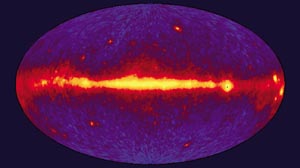
A brief history of gamma-ray astronomy
High-energy gamma-ray astronomy from space has a long history, via NASA’s SAS 2 satellite, which was launched in November 1972, and the European COS-B satellite, which was launched in August 1975, culminating in results such as the gamma-ray sky map (see above) produced by the EGRET instrument on NASA’s big Compton Gamma Ray Observatory.
This map illustrates the key features mentioned above – the bright gamma-ray continuum tracing the Milky Way results from cosmic rays interacting with interstellar gas. As the distribution of gamma rays follows the column density of gas closely, one concludes that cosmic rays pervade the Milky Way more or less uniformly.
Superimposed onto the continuum are well over 200 point sources, which is indicative of cosmic particle accelerators. About a third of these sources can be identified with known galactic and extragalactic objects, such as pulsars or quasars. The character of the remaining ones is open.
Owing to their small (less than a square metre) detection areas, combined with the steeply falling energy spectrum of gamma rays, satellite instruments are, however, limited in their energy range and cannot reach the TeV (1012 eV) or PeV (1015 eV) energy range relevant for the study of very-high-energy cosmic-ray sources. Only ground-based instruments can currently provide the required large detection areas.
Ground-based detectors
Many attempts to detect high-energy gamma rays with air shower arrays failed to provide convincing results. The breakthrough finally came with the imaging atmospheric Cherenkov telescopes, which were pioneered with the Whipple telescope in Arizona. These instruments see the air showers initialized by high-energy gamma rays using the Cherenkov radiation generated by the shower particles in the air. The intensity of the shower image provides a measure for the energy of the primary; the orientation of the image is used to determine the direction of the primary; and the shape of the image can be used to separate gamma-induced showers from the showers generated by nucleonic cosmic rays.
In 1989 the Whipple group succeeded in establishing the Crab nebula as a strong galactic source of TeV gamma rays, and then discovered two extragalactic sources – the active galactic nuclei Markarian 421 and 501. More recently, high-energy gamma-ray astronomy has attracted additional interest because it both permits novel investigations in observational cosmology and provides a means with which to search, via their annihilation radiation, for neutralino dark matter candidates accumulating in the centres of galaxies.
Imaging techniques
The imaging atmospheric Cherenkov technique has progressed significantly since the days of the first Whipple telescope.
Stereoscopic observation of air showers by multiple telescopes, as was implemented in the five-telescope HEGRA system (the High Energy Gamma Ray Astronomy telescope in La Palma built by a German-Spanish-Armenian collaboration) and the fine-grained imaging achieved by the CAT telescope camera (Cherenkov Array at Themis, in the French Pyrenees), provide improved shower reconstruction and sensitivity.
The next-generation HESS telescopes build on these developments. They are designed and constructed by an international collaboration of Armenian, Czech, English, French, German, Irish, Namibian and South African researchers. The telescope system combines the stereoscopic imaging of air showers pioneered by the HEGRA telescope system, the fast trigger electronics used in the CAT telescope, and monitoring techniques developed for the Durham and Potchefstroom telescopes to provide an overall ten-fold increase in sensitivity over current instruments.
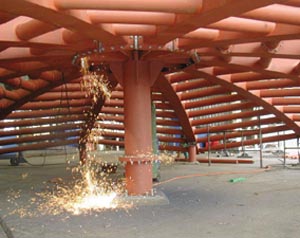
In Namibia
The HESS telescopes are located in the Khomas Highland of Namibia, near the Gamsberg, which was once considered as a site for the ESO optical telescopes and is renowned among astronomers for its excellent observing conditions. The location near the tropic of Capricorn provides an optimal view of sources in the central part of our galaxy and of the galactic centre region, in addition to the many extragalactic sources that should be discovered.
The mild climate allows the telescopes to be operated without protective enclosures. At 100 km from the capital of Namibia, Windhoek, access to the site is easy. In a vast plain, the site provides ample space for the future expansion of the system.
In its first stage, HESS will comprise four telescopes of the 12 m diameter class. These have a mirror area of 105 m2with a focal length of 15 m. The mirror is composed of 382 round mirror elements of 60 cm diameter. An alt-az (horizon-based co-ordinate system) mount allows objects to be tracked across the sky. Cherenkov shower images are viewed by a camera of 960 photomultiplier tubes, each subtending an angle of 0.16°.
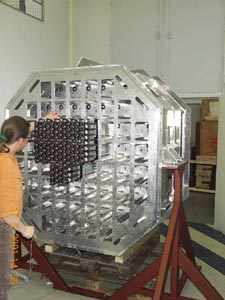
The large field of view of the camera (5°) is optimal for the investigation of extended sources such as supernova remnants and allows extensive sky surveys. The photomultipler signals are sampled at a rate of 1 GHz, and they are digitized and read out if a minimum number of photomultipliers (three to five) show coincident signals of several photoelectrons.
The effective detection area of the HESS instrument is determined by the diameter of the Cherenkov light pool, and it varies between 70 000 m2 at 100 GeV, up to almost 300,000 m2 at TeV energies, to be compared with less than a square metre of satellite instruments. The directions of individual gamma rays can be reconstructed with 0.1° precision. One expects that strong gamma-ray point sources can be located with an error of a few arc-seconds.
Construction on the site began in August 2000 with the telescope foundations. The steel structures for the telescopes are built in Namibia. The mount of the first telescope was assembled in May, and work on the next telescope is in progress. In Europe, the cameras and the mirrors for the telescopes are being prepared for installation. The first telescope is expected to go into operation late in 2001, the next three up to 2003.
Together with major new Cherenkov telescope projects under construction in the US (VERITAS), in Australia (CANGAROO) and on the Canary Island of La Palma (MAGIC), HESS will provide excellent sky coverage at TeV energies.
It is a fitting acronym – Viktor Hess received the 1936 Nobel Prize for his discovery of cosmic rays.
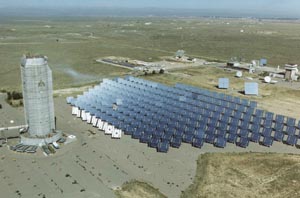
STACEE in New Mexico
A novel gamma-ray telescope has recently been commissioned and is observing powerful sources of GeV/TeV gamma rays, such as active galactic nuclei. The Solar Tower Atmospheric Cherenkov Effect Experiment (STACEE) uses an array of heliostats (solar mirrors) at the National Solar Thermal Test Facility of Sandia National Laboratories in Albuquerque, New Mexico.
The heliostats are used to collect Cherenkov light from the shower of secondary particles produced by a high-energy gamma ray of galactic or extragalactic origin as it enters the atmosphere. The Cherenkov light collected by the heliostats is concentrated onto an array of photomultiplier tubes. STACEE uses many experimental techniques first developed for subatomic physics experiments. Observations in the gamma-ray energy range from 50 to 250 GeV are important for understanding many high-energy astrophysical objects, especially pulsars, supernova remnants and gamma-ray bursts.
STACEE is designed to study astrophysical sources of gamma radiation in this energy range, which has not yet been explored by previous imaging Cherenkov telescopes on the ground or by previous satellite experiments in space.
The STACEE collaboration consists of 16 scientists from seven institutes in Canada and the US.
The experiment has been built in stages, with each stage using more heliostats, and improved optics and electronics. In 1999, with half of the 64 heliostats and two cameras, STACEE observed the Crab nebula at an energy threshold unprecedented by other sampling detectors.
This year, with two-thirds of the heliostats, STACEE pointed to two BL Lacertae blazars, Markarian 421 and 501. During the period January to May, enhanced X-ray and TeV gamma-ray emission from Markarian 421 was reported. A significant signal from Markarian 421 has been observed and analysis of the Markarian 501 data is ongoing. The low-energy threshold allows extension of the gamma-ray spectrum of Markarian 421, thereby placing additional constraints on emission models during outburst.



